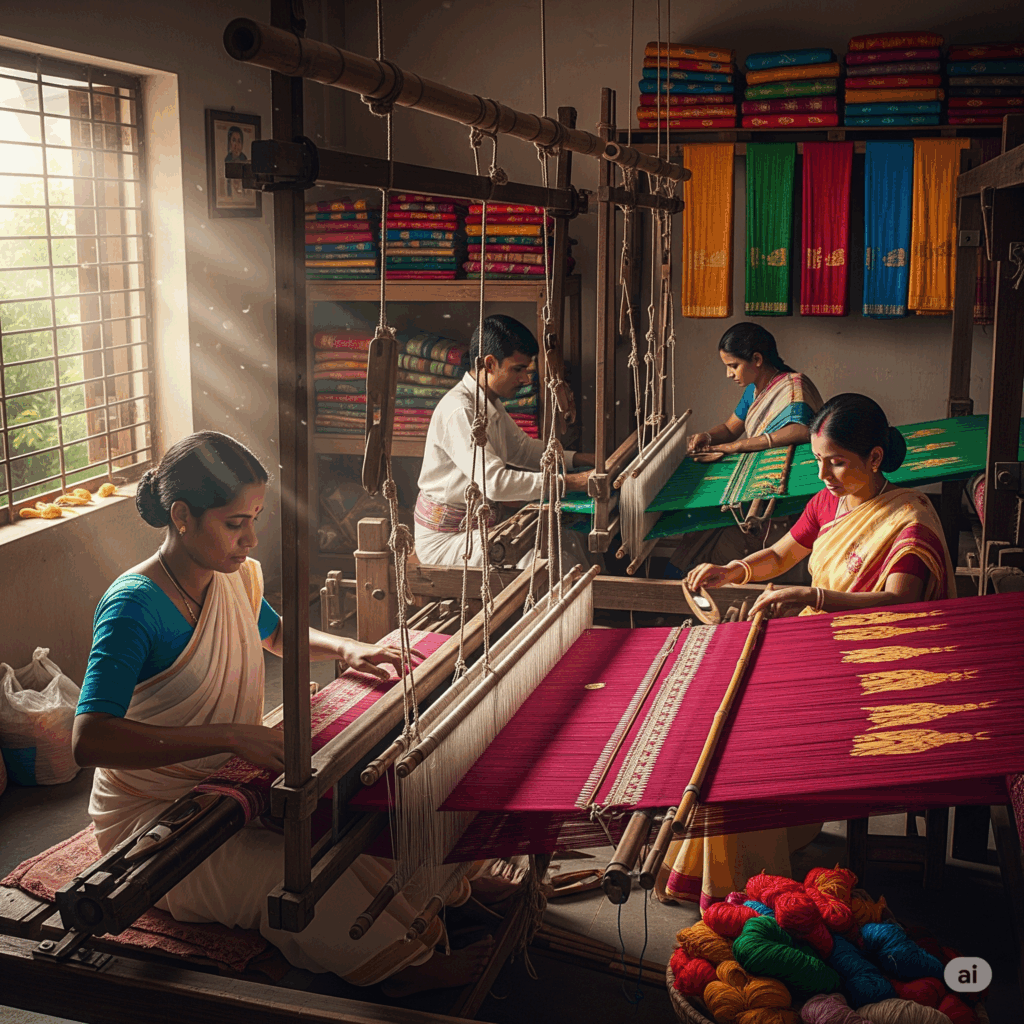From the exquisite heritage of Murshidabad silk to t the rich tradition of Tamil Nadu silk, silk comes in many forms—each with its own story, origin, and unique appeal. This guide explores the different kinds of silk, their characteristics, and why they continue to be treasured as the fabric of luxury across cultures.
1. Murshidabad Silk: From the Days of Nawabs to the Looms of Today
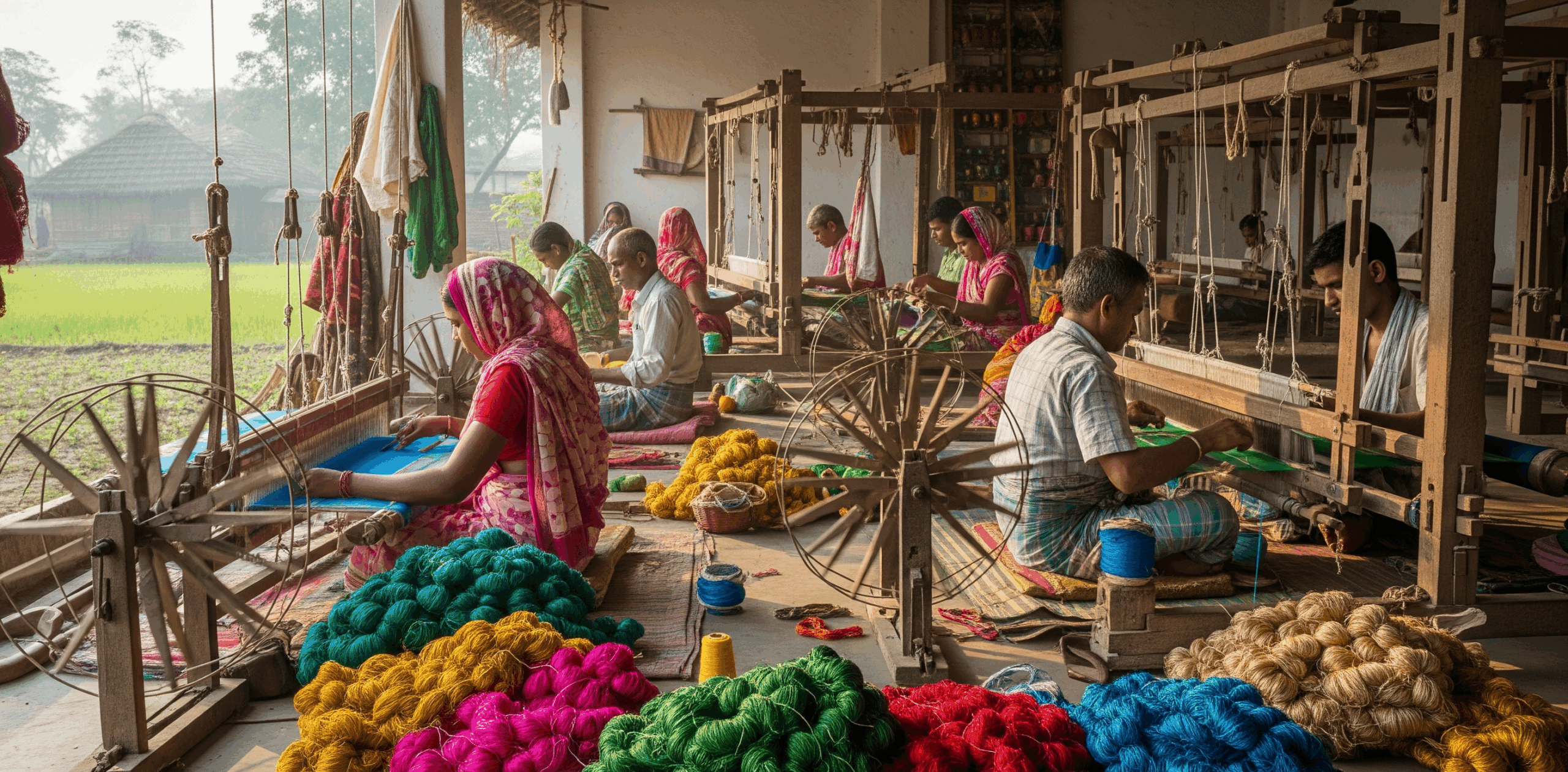
When you hear the word silk, your mind may wander to the luxury of Benarasi or the sheen of Kanchipuram. But tucked away on the banks of the Bhagirathi in West Bengal lies Murshidabad, a district where silk is not just a fabric but a living piece of history.
The Royal Beginning: Nawabs and the Golden Loom
The story of Murshidabad silk begins in the 18th century, when the city was the capital of Bengal under Nawab Murshid Quli Khan. The Nawabs patronized local artisans, making silk weaving one of the most celebrated crafts of the time. Murshidabad’s mulberry silk, soft yet lustrous, became a symbol of refinement — favored in courts not only in Bengal but across Europe.
The famed Murshidabad Silks were shipped to England by the East India Company, where they became an exotic luxury for aristocrats. From the palaces of Bengal to the drawing rooms of London, this fabric was proof that Bengal’s loom was the heartbeat of global trade.
The Weavers’ Tale: Generations on the Loom
Behind this grandeur were thousands of weavers, often belonging to families who had guarded the art for centuries. Every strand of silk was reeled painstakingly by hand, every motif woven with precision. Traditional motifs included florals, paisleys, and geometric patterns, echoing both Mughal artistry and Bengali aesthetics.
But with the fall of the Nawabs and the shifting priorities of colonial rule, Murshidabad’s silk industry suffered. Cheap imports and industrial production elsewhere threatened the livelihood of these weavers. Still, they endured, keeping the craft alive in their courtyards and looms, passing it down like an heirloom.
Murshidabad Silk Today: Revival Meets Reinvention
Fast-forward to today, Murshidabad silk has once again found its place in India’s cultural and fashion landscape. Designers and connoisseurs celebrate it for its lightweight texture, which makes it perfect for Bengal’s humid climate, and its adaptability to both traditional and modern drapes.
- • Sarees: The most famous product — Murshidabad silk sarees are airy, elegant, and versatile, often hand-painted or block-printed with intricate designs.
- • Scarves & Stoles: These lightweight silks now travel the globe as accessories, blending heritage with contemporary fashion.
- • Fusion Wear: From kurtas to jackets, fashion houses experiment with Murshidabad silk to give a modern edge to a centuries-old fabric.
The rise of sustainable fashion has also added momentum. Murshidabad silk, being eco-friendly and handwoven, fits perfectly into the narrative of slow, conscious fashion.
The Struggles: Looms That Need Support
Despite its beauty, Murshidabad silk weaving is still a fragile livelihood. Weavers often struggle with poor wages, lack of market access, and competition from machine-made textiles. Many younger generations drift toward other jobs, leaving the art vulnerable.
Yet, NGOs, cooperatives, and even fashion designers are stepping in. Initiatives that connect rural weavers directly to urban markets and global buyers are bringing fresh hope. The digital era has given Murshidabad silk a new stage — Instagram shops and online exhibitions now carry forward what once sailed in ships to Europe.
Why Murshidabad Silk Matters
Fashion isn’t just about trends; it’s about stories. When you drape a Murshidabad silk saree, you’re not just wearing fabric — you’re carrying centuries of history, the sweat of artisans, the vision of Nawabs, and the resilience of Bengal’s heritage.
In a world of fast fashion, Murshidabad silk reminds us of patience, craftsmanship, and continuity. It is an emblem of how culture adapts, survives, and shines anew.
The Future: From Heritage to Global Catwalks
The future of Murshidabad silk depends on how we value it today. If nurtured, it can stand alongside the biggest names in luxury fabrics — not just in India but globally. Imagine haute couture gowns in Paris stitched with Murshidabad silk, or sustainable fashion brands in New York embracing it as their eco-friendly signature.
It’s possible, because Murshidabad silk carries both timeless elegance and modern relevance.
✨ Closing Note:
From the Nawabs’ courts to your wardrobe today, Murshidabad silk has traveled centuries. It whispers stories of empire, resilience, and reinvention — and in every thread lies a reminder that true luxury is born not in factories, but in the hands of artisans.
2. Mysore Silk: A Royal Weave from Palaces to Present
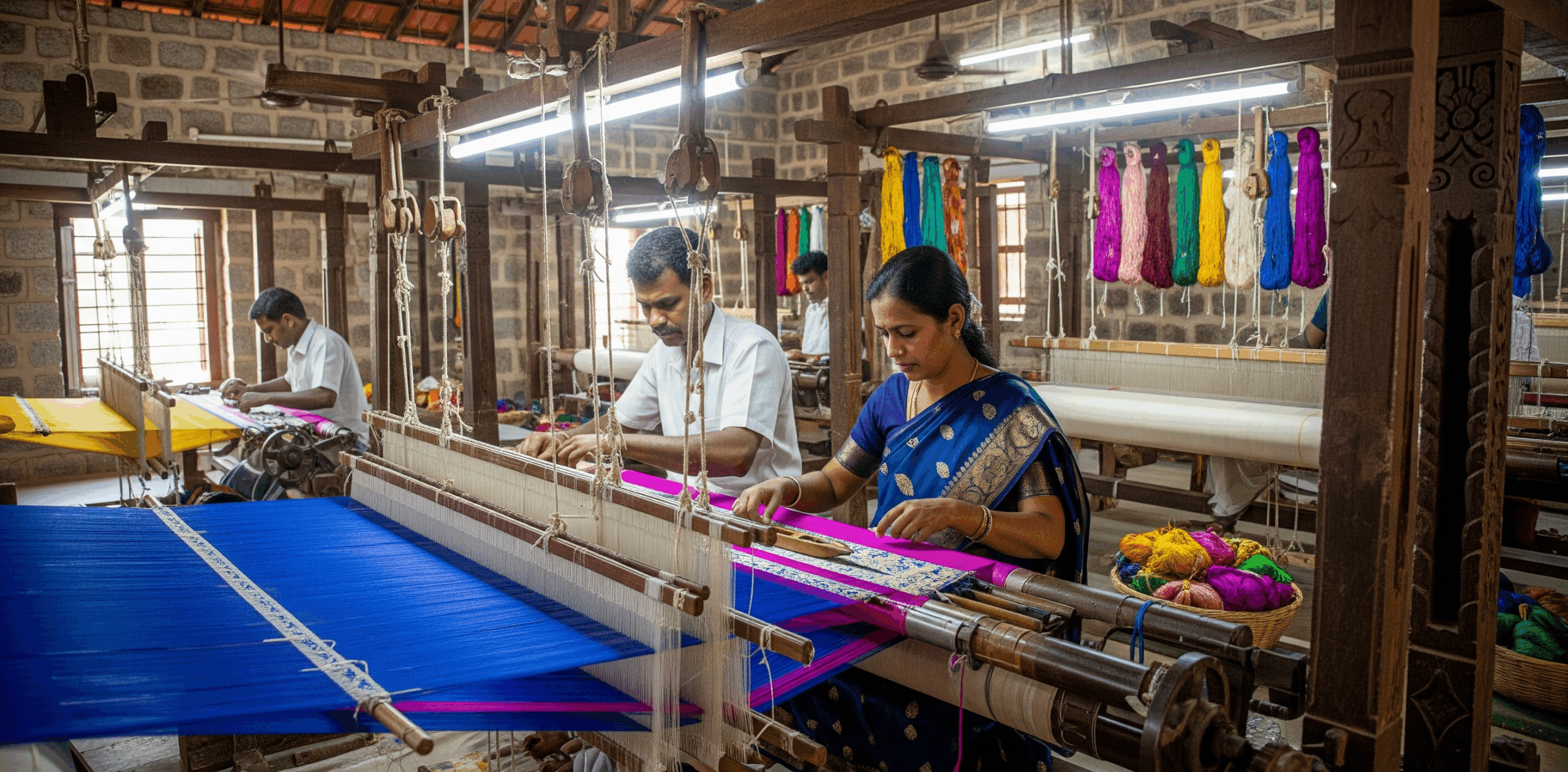
When you think of timeless elegance in Indian fashion, Mysore Silk is sure to shine on that list. Known for its unmatched softness, vibrant colors, and luxurious feel, Mysore silk is more than a fabric — it’s a heritage.
The Royal Origins: Woven for the Maharajas
The story of Mysore silk begins in the early 20th century under the reign of Krishnaraja Wodeyar IV, the Maharaja of Mysore. Fascinated by the silk trade in Europe, he envisioned bringing that same grandeur to India. With royal patronage, silk weaving workshops flourished in Mysore, producing sarees that were as much a mark of royalty as the jewels in the Wodeyars’ treasure chest.
The silk was crafted from the finest mulberry silk, and the hallmark became its pure gold zari borders and understated elegance. Unlike the ornate heaviness of Banarasi or Kanchipuram, Mysore silk carved its identity in minimalism with class.
The Craftsmanship: Purity in Every Thread
What makes Mysore silk so special? It’s the purity. Authentic Mysore silk sarees are woven with:
- • 100% Mulberry Silk – smooth, soft, and with a natural shine.
- • Real Gold & Silver Zari – not the imitation threads you find in market knock-offs.
- • Handloom Precision – every saree takes days, sometimes weeks, to complete.
And here’s the kicker: every genuine Mysore silk saree carries a unique code and hologram issued by the Karnataka Silk Industries Corporation (KSIC). That’s how you know you’re wearing heritage, not just fabric.
Colors of Karnataka: Bold, Bright, Beautiful
If you’ve ever seen a Mysore silk saree, you know it’s impossible to miss. The colors are rich, often in deep reds, royal blues, emerald greens, and striking yellows — hues that reflect Karnataka’s vibrancy. Unlike other silks overloaded with motifs, Mysore silk keeps it simple: plain body, bold color, gold border. It’s minimalism at its royal best.
From Palaces to Weddings: The Cultural Symbol
Over time, Mysore silk became synonymous with auspicious occasions. To this day, no South Indian wedding trousseau feels complete without at least one Mysore silk saree. It’s not just attire — it’s a symbol of prosperity, tradition, and heritage.
Women across generations treasure their Mysore silk sarees, often passing them down as heirlooms. A grandmother’s saree becomes a granddaughter’s wedding drape — proof of silk’s timeless bond with family traditions.
Mysore Silk in Today’s Fashion
Fashion, like history, reinvents itself — and Mysore silk is no exception. Today, designers are blending Mysore silk with modern cuts and trends:
- • Fusion Sarees with lighter zari and contemporary hues.
- • Silk Lehengas & Gowns that take the fabric beyond sarees.
- • Accessories like clutches, dupattas, and stoles made of Mysore silk.
In a world of fast-changing trends, Mysore silk’s minimal luxury makes it evergreen. Its lightweight drape makes it easy to carry, even for younger generations who want tradition without the fuss.
Challenges & Preservation
Like most traditional crafts, Mysore silk faces challenges from cheaper machine-made alternatives. Fake silks flood the markets, and many buyers don’t realize they’re losing touch with authenticity.
But organizations like KSIC and conscious fashion movements are reviving interest. Campaigns for sustainable, handwoven fabrics are once again pushing Mysore silk into the spotlight — not just as attire but as a legacy worth preserving.
Why Mysore Silk Still Matters
In today’s fashion universe, where trends vanish overnight, Mysore silk stands tall as a reminder of heritage, purity, and elegance. When you drape Mysore silk, you’re not just wearing a saree — you’re wearing a century-old story of royalty, artisanship, and culture.
3. Tamil Nadu Silk: The Fabric That Carries the Soul of Temples
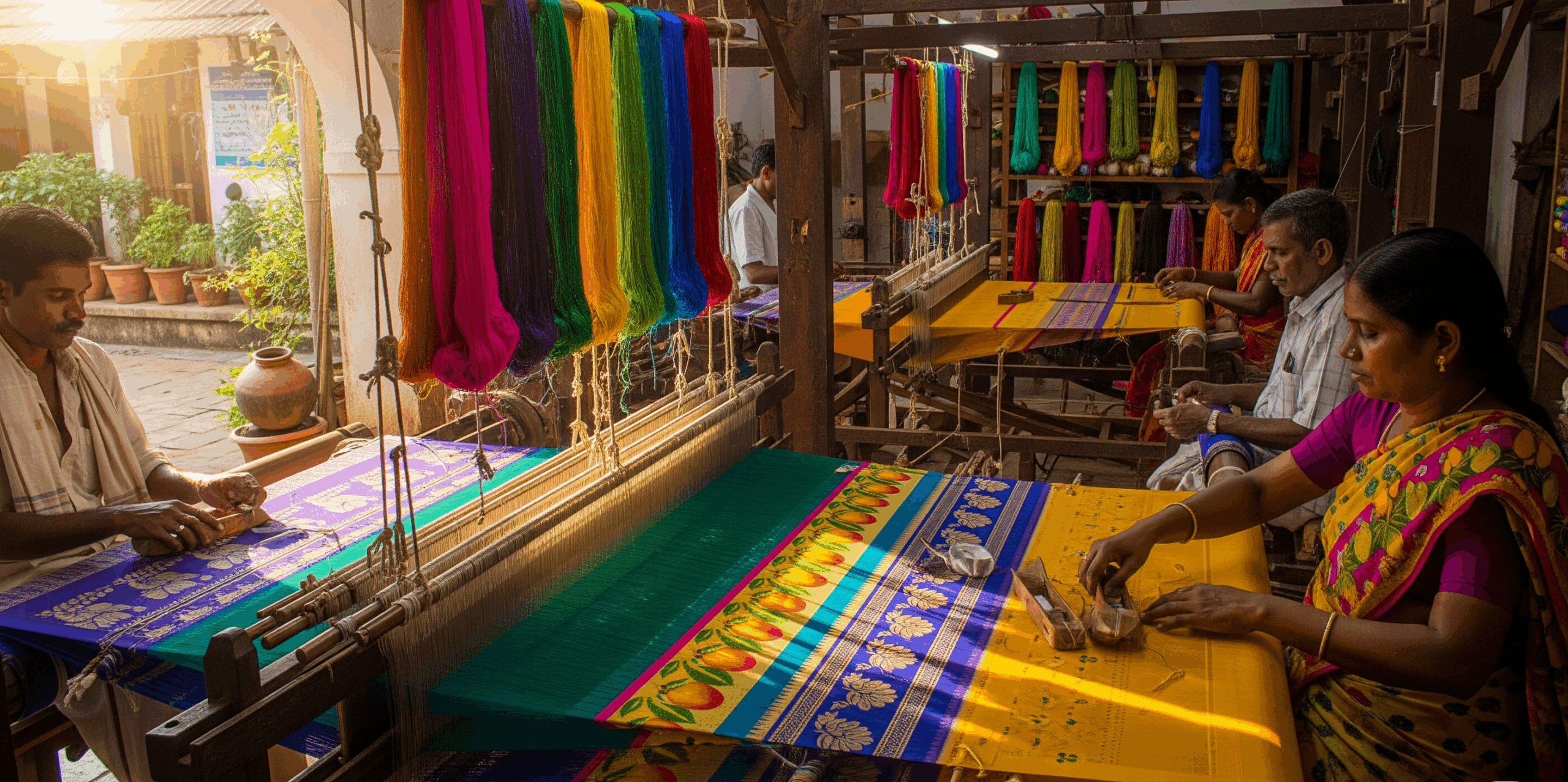
When you think of silk in India, one name instantly rises above the rest: Tamil Nadu silk. In particular, the legendary Kanchipuram saree. Worn by brides, blessed in temples, celebrated in films — this silk is more than a textile. It is living architecture, carrying the carvings of South Indian temples into fabric form.
A Legacy Woven in Temple Towns
Tamil Nadu’s silk story is most famously rooted in Kanchipuram, a city often called the “Silk City of India.” The weavers here trace their lineage back to the time of the Pallava kings (4th–9th century). According to legend, Sage Markandeya, a devotee of Lord Shiva, was considered the first weaver, and his descendants continued the craft in Kanchipuram.
Why Kanchipuram? Because it was not only a temple town but also a thriving hub of art, philosophy, and devotion. The grandeur of the temple architecture — the tall gopurams, the stone pillars, the intricate carvings — all found echoes in the motifs and borders of these sarees.
Silk as Sacred Offering
In Tamil Nadu, silk is never just cloth. It is sacred attire. The idols of gods and goddesses in temples are adorned with pure silk garments, believed to be a mark of honor and divinity. No major puja or wedding is considered complete without silk making its appearance.
When a Tamil bride drapes a Kanchipuram saree, she is not just wearing a wedding outfit — she is carrying centuries of blessings and sanctity on her shoulders.
What Makes Tamil Nadu Silk Different?
While many parts of India produce silk, Tamil Nadu silk stands apart because of its strength, grandeur, and design language.
- • Double Warp and Double Weft: Kanchipuram sarees are famous for their unique weaving technique where the body and border are woven separately and then joined with precision. The join is so strong that even if the saree tears, the body and border will not come apart.
- • Heavy, Durable Fabric: The density of the weave makes these sarees last for generations. A well-kept Kanchipuram can easily outlive its first owner.
- • Temple-Inspired Motifs: Borders with temple towers, checks, stripes, rudraksha, peacocks, elephants, and mango designs dominate these sarees, each motif carrying cultural symbolism.
- • Pure Zari: Traditionally, the zari (gold thread) was made of silver dipped in gold, which gave it a genuine shine that never faded.
The Dance of Colors
One of the most enchanting qualities of Tamil Nadu silk is its contrasting colors. Imagine a rich emerald green body with a shocking pink border, or a deep maroon paired with bright mustard. The play of dual tones creates drama, ensuring that a Kanchipuram saree is always noticed, never ignored.
These bold contrasts, paired with shimmering zari, make Tamil Nadu silk sarees a visual feast — perfect for weddings, Bharatanatyam performances, and grand occasions.
Beyond Kanchipuram: Other Silks of Tamil Nadu
Though Kanchipuram steals the spotlight, Tamil Nadu is home to many other silk varieties:
- • Arani Silk: Known for its softness and lightweight texture, often woven with traditional temple motifs.
- • Kumbakonam Silk: Popular in smaller towns, recognized for unique weaving techniques.
- • Madurai Sungudi (part silk): A mix of silk and cotton, originally patronized by the Nayak rulers.
- • Chettinad Silk: Distinguished by bold stripes and checks, echoing the heritage of the Chettiar community.
Together, these weaves show that Tamil Nadu is not just a producer of silk — it is a land of textile diversity.
The Weavers: Guardians of Tradition
Behind every Tamil Nadu silk saree lies the sweat and devotion of weaving communities. For generations, entire families have lived and breathed the art of handloom weaving. The process is painstaking:
- Dyeing the yarn in vibrant hues.
- Setting up the loom, which itself takes several days.
- Weaving motifs by hand, sometimes involving three weavers working together on a single saree.
A single saree can take anywhere from 10 days to 6 months, depending on its complexity. And in that time, what is woven is not just fabric but patience, devotion, and identity.
Tamil Nadu Silk in Global Fashion
In today’s globalized world, Tamil Nadu silk has stepped out of its traditional borders. Fashion designers across India and abroad have experimented with Kanchipuram silk, using it for gowns, jackets, skirts, clutches, and even shoes.
At high-profile weddings, red carpets, and cultural festivals, Tamil silk continues to make appearances — proof that even in modern fashion, there is room for timeless heritage.
Challenges Facing the Craft
Despite its grandeur, Tamil Nadu silk is not free from struggles:
- • Powerloom Imitations: Machine-made sarees often pass off as handloom Kanchipuram at cheaper prices, hurting the reputation of authentic weavers.
- • Declining Weaver Numbers: Younger generations often move away from weaving due to poor incomes and hard labor.
- • Market Shifts: Today’s buyers often look for lightweight and budget-friendly sarees, while pure Kanchipuram silks are heavy and expensive.
Organizations, NGOs, and government schemes are working to protect the handloom sector, but it remains a fight for survival.
Why Tamil Nadu Silk Still Rules Hearts
Despite modern trends and imitations, Tamil Nadu silk holds a power that cannot be replaced. A woman in a Kanchipuram saree does not just look dressed up — she looks regal, grounded, and timeless.
It is a saree that does not just flatter the body but also connects the wearer to something larger — to temples, to gods, to heritage, to the idea of India itself.
A Saree That Becomes Memory
Ask any Tamil family, and you’ll hear stories of silk sarees stored carefully in cupboards, wrapped in muslin, waiting for the next wedding or festival. These sarees are not just worn; they are lived in. They carry the fragrance of turmeric, the sound of temple bells, the laughter of family gatherings.
And when they are passed down to the next generation, they carry with them not just fabric but memory and love.
The Final Word
Tamil Nadu silk is not fashion. It is heritage draped in six yards. It has survived dynasties, economic changes, and modern fashion waves — and still remains a crown jewel of Indian textiles.
When you touch a Kanchipuram saree, you are not just feeling silk. You are feeling the soul of Tamil Nadu — its temples, its traditions, its resilience, and its eternal sense of grandeur.
4. Khadi: The Fabric of Freedom and Future
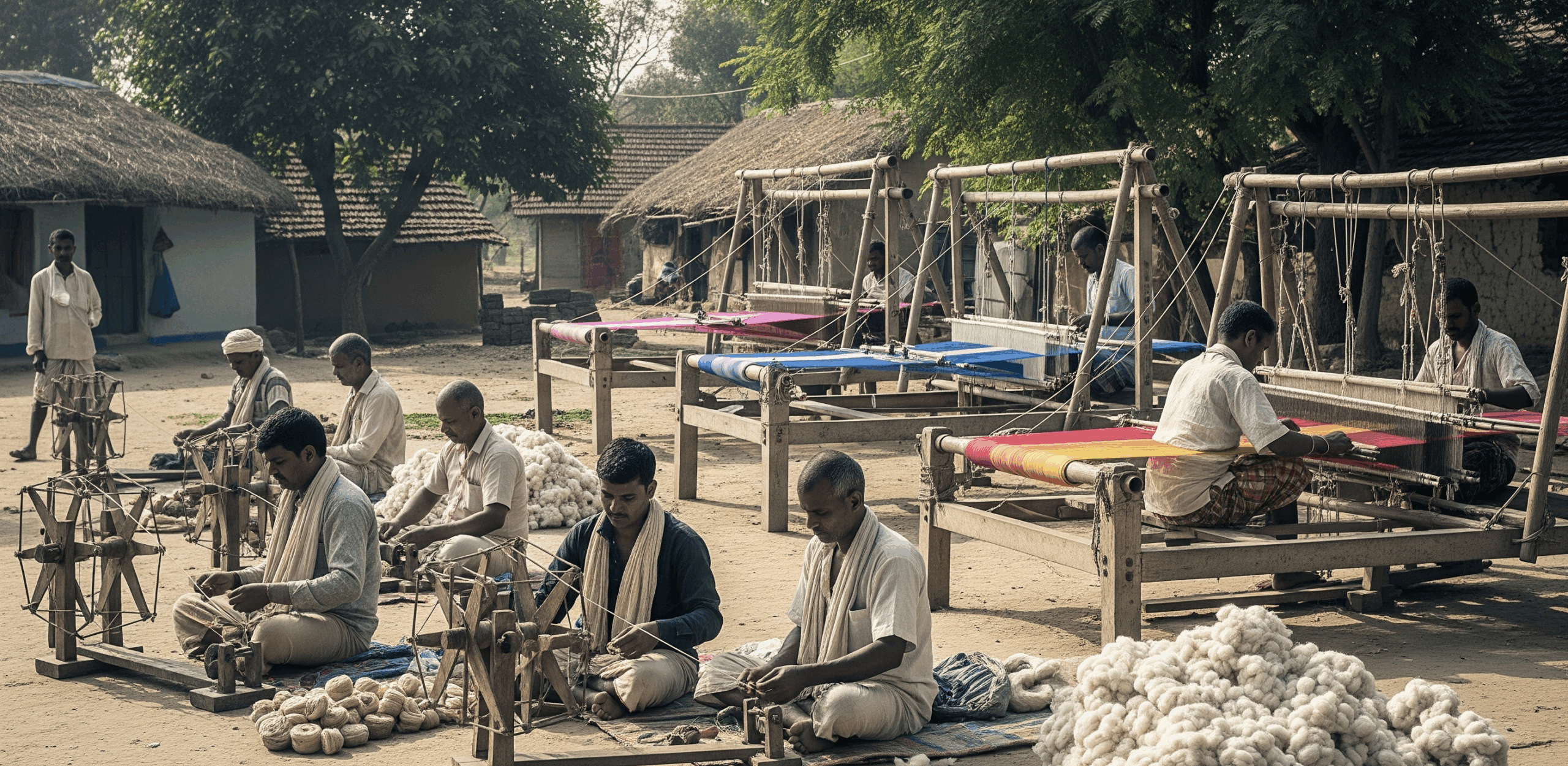
Khadi is not just a textile—it is an idea, a symbol, and a movement. For most of us, the word “Khadi” instantly evokes images of Mahatma Gandhi spinning yarn on a charkha, or politicians dressed in crisp white kurtas. But this humble handspun and handwoven cloth carries with it a history that shaped India’s independence struggle, an enduring philosophy of sustainability, and a contemporary revival in global fashion.
To understand Khadi is to understand the journey of India itself—from colonial subjugation to self-reliance, from grassroots craftsmanship to haute couture runways.
Origins: The Humble Beginnings of Handspun Cloth
The origins of Khadi predate colonial India. For centuries, Indian villages thrived on the rhythm of spinning and weaving. Cotton grew abundantly in the subcontinent, and skilled weavers across regions produced fabrics that were sought worldwide. Greek and Arab traders carried Indian cotton to faraway lands, and by the 16th century, Indian textiles were considered among the finest in the world.
But Khadi as we know it today was born much later—out of political necessity and spiritual conviction.
Colonial Disruption and the Spark of Resistance
When the British East India Company took control of India’s economy, it systematically destroyed local textile industries. India, once the textile hub of the world, was reduced to a supplier of raw cotton to British mills. The finished cloth came back to India at high prices, while Indian weavers lost livelihoods. This was not just economic exploitation—it was cultural erasure.
It was against this backdrop that Khadi became more than cloth. It became resistance.
Gandhi’s Charkha: A Spinning Wheel of Revolution
In the early 20th century, Mahatma Gandhi reintroduced Khadi to the nation as both a political and spiritual tool. His simple act of spinning yarn on the charkha (spinning wheel) carried profound meaning. To Gandhi, Khadi symbolized swaraj (self-rule). If Indians spun their own cloth, they would weaken the economic chains of colonial rule.
Every thread spun on the charkha was a thread of independence. Wearing Khadi was no longer about fashion—it was a declaration of defiance. Gandhi urged Indians to boycott British textiles and adopt Khadi as a badge of dignity and unity. Soon, Khadi became the uniform of freedom fighters, embodying resilience, self-sufficiency, and solidarity.
Post-Independence: From Symbol to Institution
When India achieved independence in 1947, Khadi’s role evolved. No longer just a weapon against colonial powers, it became a cornerstone of nation-building. The government established the Khadi and Village Industries Commission (KVIC) in 1957 to promote handspun, handwoven fabrics and support rural artisans.
Khadi now stood for employment, sustainability, and rural empowerment. It wasn’t just about cloth; it was about keeping alive a way of life—slow, mindful, and rooted in the soil of India’s villages.
The Craft of Khadi: More Than Just Fabric
At its heart, Khadi is about patience and precision. The process begins with cotton fibers hand-spun into yarn using a charkha. This yarn is then woven on handlooms, often in small village homes. Unlike machine-made cloth, Khadi breathes—it feels warm in winter and cool in summer. Its irregular texture, far from being a flaw, is its charm. Every wrinkle, every slub in Khadi tells a story of human touch.
This labor-intensive process also sustains thousands of rural families, especially women, who find both employment and dignity through spinning and weaving.
Khadi in Contemporary Fashion: From Village to Vogue
For decades, Khadi was seen as the attire of politicians and the elderly—a fabric stuck in sepia tones of history. But in recent years, designers have reimagined Khadi as a canvas of endless possibilities. Today, it appears not just in kurtas and saris but also in jackets, dresses, trousers, and even haute couture gowns.
Fashion houses in India and abroad have embraced Khadi’s raw appeal. Designers like Sabyasachi, Ritu Kumar, and Rajesh Pratap Singh have used Khadi in their collections, giving it a modern, luxurious edge. Internationally, Khadi has made appearances on runways in Paris, Milan, and New York, celebrated for its sustainability and timeless charm.
Why Khadi is the Fabric of the Future
In an age where fast fashion dominates and the planet groans under environmental stress, Khadi feels more relevant than ever. Here’s why:
- Eco-Friendly – Khadi production uses little to no electricity, relying on manual labor. Its carbon footprint is far lower than machine-made fabrics.
- Sustainable Employment – It provides livelihoods to rural artisans, keeping traditional crafts alive.
- Slow Fashion – Khadi promotes mindful consumption, reminding us that fashion need not be disposable.
- Breathable & Versatile – Comfortable across seasons, Khadi adapts seamlessly to modern styles while retaining its earthy essence.
In short, Khadi aligns perfectly with today’s global push toward sustainable fashion and ethical consumerism.
Cultural Symbolism: Wearing Identity on a Sleeve
Khadi has never been “just cloth.” Wearing Khadi means wearing history, values, and identity. In India, it continues to represent simplicity, authenticity, and groundedness. Politicians still wear Khadi to project humility and connection to the masses, though critics argue that this symbolism has sometimes turned performative.
For the youth, however, Khadi is being rediscovered—not as a relic, but as a cool, sustainable choice. Brands are experimenting with bold colors, contemporary cuts, and fusion designs, making Khadi fashionable without stripping it of meaning.
Khadi Beyond India: A Global Story
Khadi’s journey has also gone global. From eco-conscious fashion circles in Europe to sustainability-driven brands in the U.S., Khadi has found admirers abroad. Its story resonates universally—local craft standing tall against industrial exploitation, human touch triumphing over mechanization.
The KVIC has even signed MoUs with international brands to promote Khadi textiles globally, branding it as India’s gift to the world.
The Road Ahead: Preserving Legacy, Inspiring Innovation
Khadi’s challenge today is to balance heritage with modernity. On one hand, it must remain faithful to its roots—handspun, handwoven, and rural. On the other, it must adapt to modern consumer demands, providing variety, style, and affordability.
The future of Khadi lies in innovation: organic dyes, digital marketing, collaborations with designers, and exports that tell its story to the world. More importantly, it lies in us—the consumers. Every time we choose Khadi, we support not just fabric, but livelihoods, history, and sustainability.
Conclusion: A Fabric That Wears History and Hope
Khadi began as cloth for the body but became cloth for the soul of a nation. From Gandhi’s spinning wheel to global fashion ramps, its journey is a testament to resilience and reinvention. It reminds us that fashion can be political, ethical, and spiritual all at once.
In a world chasing speed, Khadi whispers the value of slowness. In a marketplace ruled by mass production, Khadi celebrates individuality. And in a planet crying out for sustainability, Khadi offers hope stitched in every thread.
Wearing Khadi today isn’t just about style—it’s about participating in a story that began centuries ago and continues to evolve. It’s a story of freedom, dignity, and a future woven by hand.
5. Banarasi Silk: A Tapestry of History, Heritage, and Timeless Craft
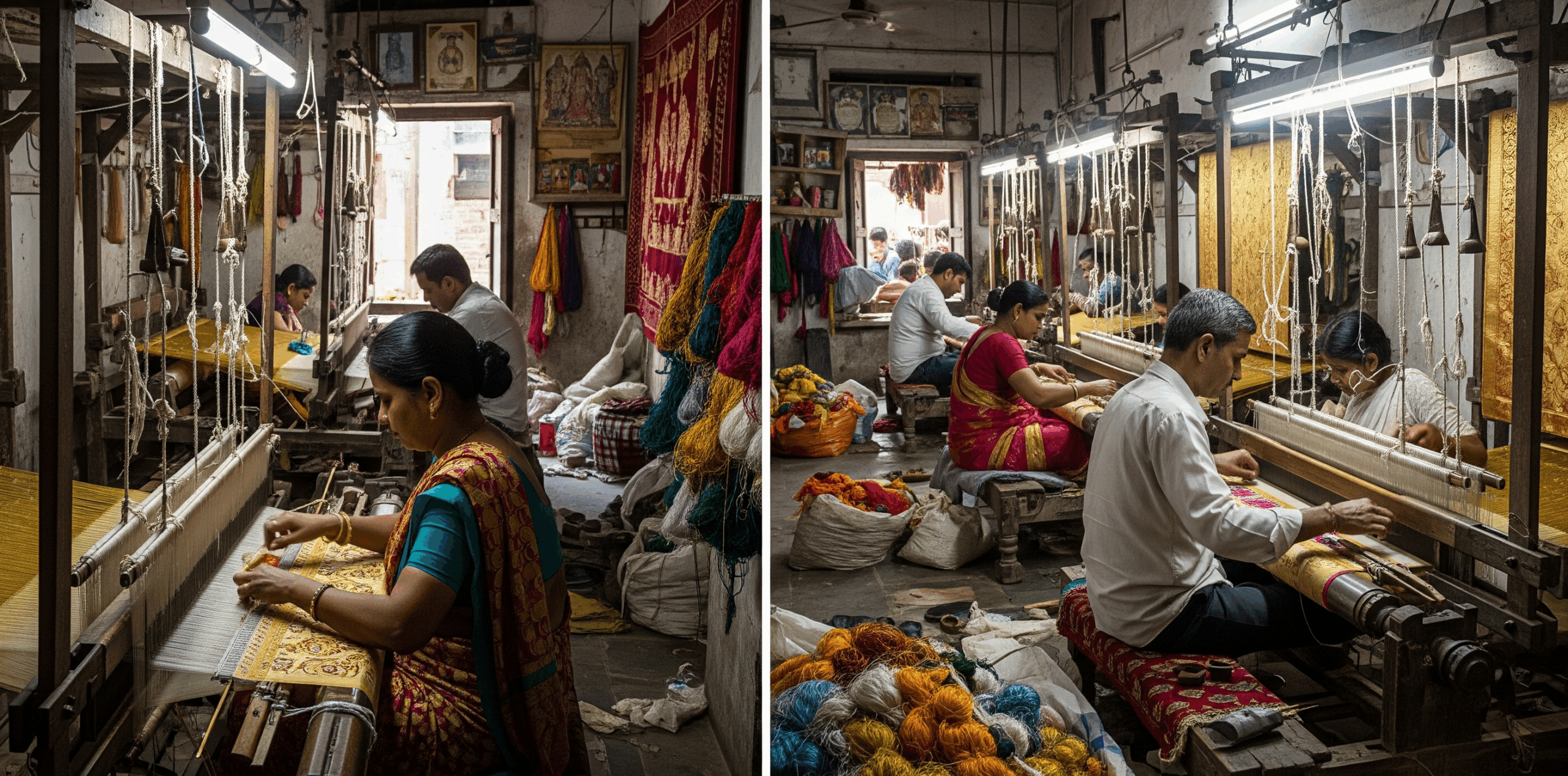
Banaras, or Varanasi as it is known today, is one of the world’s oldest living cities—a sacred confluence of spirituality, art, and culture. Nestled on the banks of the Ganges, the city has been a beacon of India’s textile traditions for centuries. Among its many treasures, Banarasi silk stands apart as a symbol of opulence, refinement, and enduring craftsmanship. To drape a Banarasi saree is to carry on your shoulders the history of an entire civilization.
But how did this luxurious fabric emerge? What gave rise to its unparalleled status in Indian and global fashion? Let’s trace the fascinating history and origin of Banarasi silk, from its royal patronage to its modern revival.
A City Woven in Gold and Silver
The story of Banarasi silk begins not merely with fabric, but with the city of Banaras itself. Known as the cultural capital of India, Banaras has been a hub of trade and art since ancient times. Its strategic location on the Ganga trade route attracted merchants, artisans, and travelers from across the world.
Silk weaving in India can be traced back to the Vedic period, but Banaras gained prominence as a weaving center around the Mughal era (16th–17th century). When the Mughal emperors brought Persian aesthetics into India, they infused Banaras with new motifs, designs, and weaving techniques. The local weavers, already skilled with silk, embraced this fusion and created something uniquely their own. This was the birth of what we today call the Banarasi weave.
Mughal Influence: The Turning Point
The Mughals were connoisseurs of art and beauty, and their courts sparkled with luxury. Emperor Akbar, in particular, had a deep love for fine fabrics and patronized artisans across his empire. Banaras weavers found favor in Mughal courts, where their skill was directed towards weaving Brocade and Zari—silks interwoven with gold and silver threads.
The Persian influence brought floral motifs, intricate creepers, and stylized patterns known as “kalga” and “bel”. These designs were seamlessly woven into silk to create textiles that rivaled the grandeur of Persian and Central Asian fabrics. What emerged was not merely cloth but art—a dazzling blend of Indian sensibilities and Mughal refinement.
By the late Mughal era, Banarasi silk had become a symbol of nobility. To own a Banarasi saree was to declare one’s wealth, status, and taste.
The Golden Age of Banarasi Weaving
Banarasi silk reached its zenith during the 18th and 19th centuries, especially under the patronage of regional kings and wealthy aristocrats. The Nawabs of Awadh, particularly, were instrumental in keeping the art alive after the decline of the Mughals.
It was during this period that the saree, as we recognize it today, became the primary canvas for Banarasi weaving. Traditionally, weavers crafted yards of luxurious fabric for turbans, lehengas, and robes. But with evolving fashion sensibilities, the saree emerged as the most iconic form of Banarasi artistry.
Each saree took weeks, sometimes months, to complete—woven on handlooms with painstaking precision. Families of weavers often worked together, passing techniques from one generation to the next.
The Weave: A Marriage of Craft and Patience
What makes Banarasi silk so extraordinary is not just the silk itself, but the method of weaving. The sarees are traditionally woven on pit looms, with artisans seated at ground level. Designs are pre-planned using graph paper, where every motif is sketched in detail before the weaving begins.
Key features of Banarasi weaves include:
- • Zari Work: Use of gold and silver threads, often real in the past, to create shimmering patterns.
- • Brocade: Raised designs woven with extra weft threads, giving depth and texture.
- • Motifs: Mughal-inspired motifs such as floral creepers, paisleys, and geometric patterns dominate.
- • Borders and Pallus: Heavy ornamental borders and intricately woven pallus are hallmarks.
A genuine Banarasi saree can take anywhere from 15 days to 6 months to complete, depending on the complexity.
Colonial Era: Challenges and Survival
The arrival of the British in India marked a dark phase for many indigenous crafts, and Banarasi silk was no exception. With the Industrial Revolution, machine-made fabrics from England began flooding the Indian market. These were cheaper, faster to produce, and threatened the livelihood of handloom weavers.
Yet Banarasi silk survived. It adapted, albeit with difficulty. Weavers began creating lighter, simpler versions to appeal to middle-class buyers. Even in those challenging times, the intrinsic beauty of Banarasi craftsmanship could not be erased.
Post-Independence Revival and Global Recognition
After India’s independence in 1947, efforts were made to preserve and promote traditional crafts. Banarasi silk was recognized as a heritage textile, and institutions were set up to protect weavers’ interests. Over time, Banarasi sarees became an indispensable part of Indian weddings.
For Indian brides, especially in North India, the Banarasi saree became the ultimate wedding attire—its shimmering zari symbolizing prosperity and its intricate designs reflecting timeless beauty. Bollywood films and Indian fashion designers further popularized Banarasi, bringing it into urban wardrobes and global runways.
In 2009, Banarasi silk was granted the Geographical Indication (GI) tag, officially recognizing its unique heritage and protecting it from imitation.
Banarasi Silk Today: A Blend of Tradition and Modernity
Today, Banarasi silk stands at an interesting crossroads. On one hand, it is steeped in tradition, representing centuries of artistry. On the other, it is being reimagined for modern fashion—used in lehengas, dupattas, gowns, and even Western silhouettes.
Top designers like Sabyasachi Mukherjee, Anita Dongre, and Manish Malhotra have revived Banarasi in haute couture, ensuring that it appeals not only to traditional brides but also to a younger, global audience.
At the same time, challenges remain. The rising cost of raw materials, competition from power looms, and declining interest among younger generations of weavers threaten the craft. Yet, many NGOs and collectives are stepping in to support artisan families, ensuring that Banarasi weaving continues to thrive.
Why Banarasi Endures
So, what makes Banarasi silk timeless? Beyond its luxury and beauty, it is the symbolism woven into each thread. A Banarasi saree isn’t just fabric; it is history carried forward, art made wearable, and memory stitched into heritage.
Every fold reflects the labor of artisans who, despite centuries of upheaval, never abandoned their looms. Every shimmer of zari tells a story—of Mughal courts, colonial struggles, and modern brides walking into new lives draped in centuries-old tradition.
Final Thoughts: Banarasi as Living Legacy
The origin and history of Banarasi silk remind us that fashion is never just about aesthetics—it is about culture, resilience, and identity. From the Mughal darbars to today’s global fashion weeks, Banarasi silk has been a constant, proving that true artistry defies time.
To own a Banarasi saree is to own a piece of India’s cultural soul. It is an heirloom that outlasts generations, a bridge between the past and the present, and a testament to how threads, when woven with passion, can hold together the story of a civilization.
✨ Banarasi silk isn’t just worn—it’s inherited, celebrated, and remembered.





